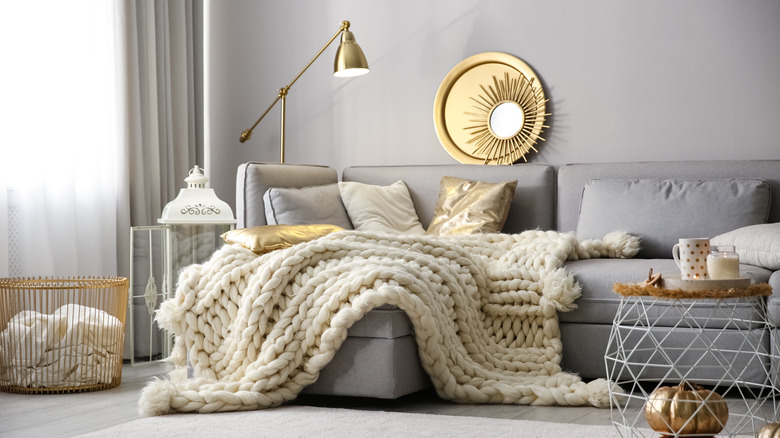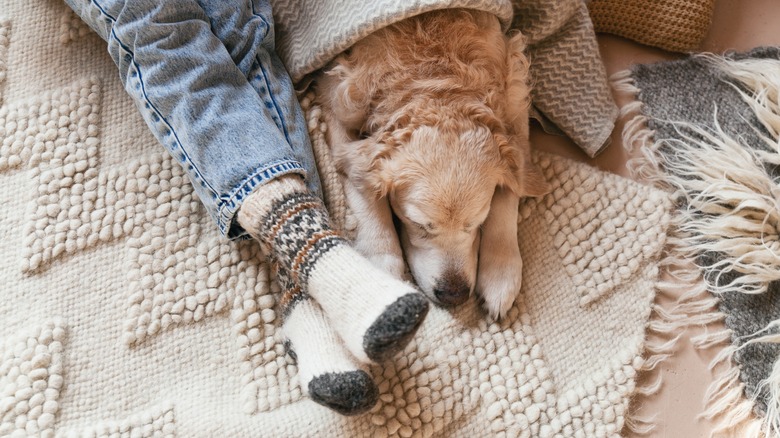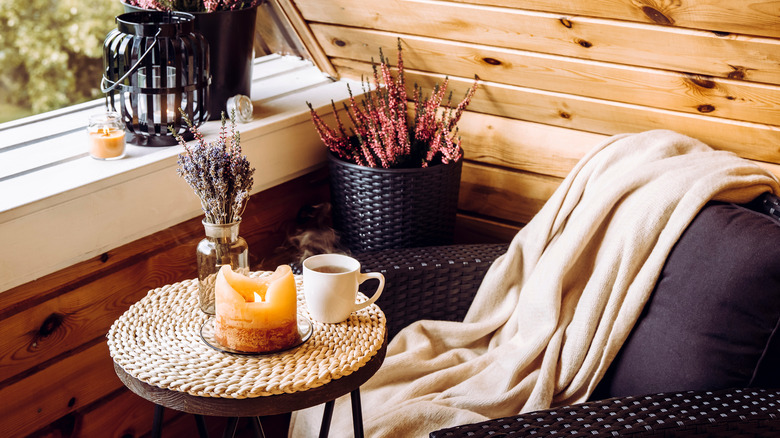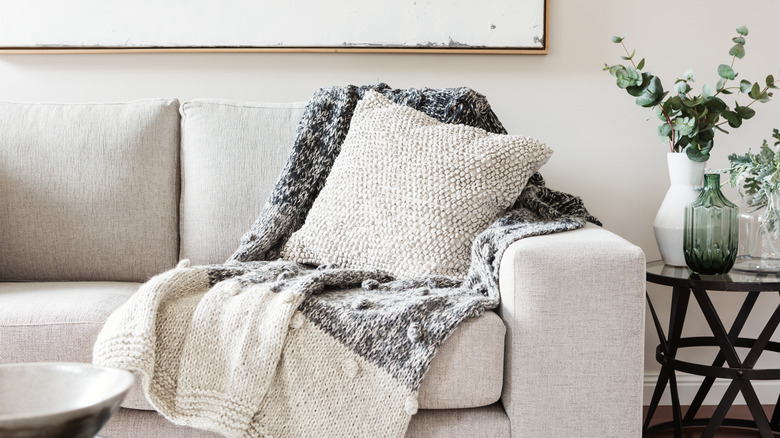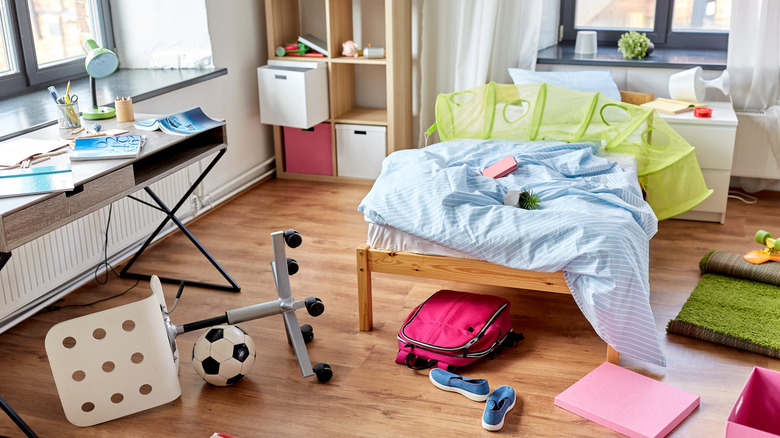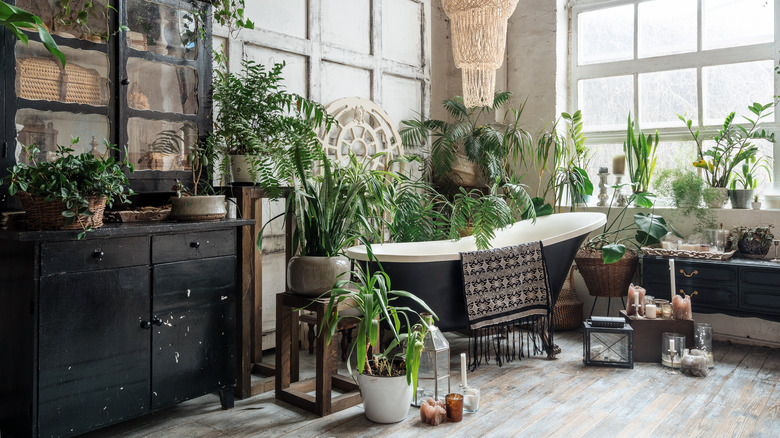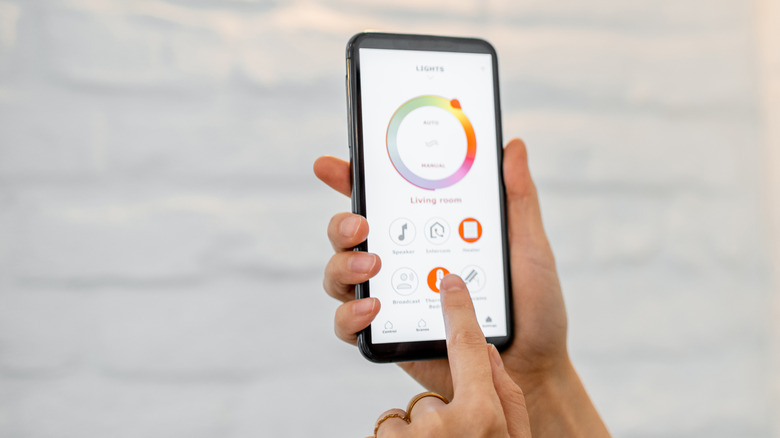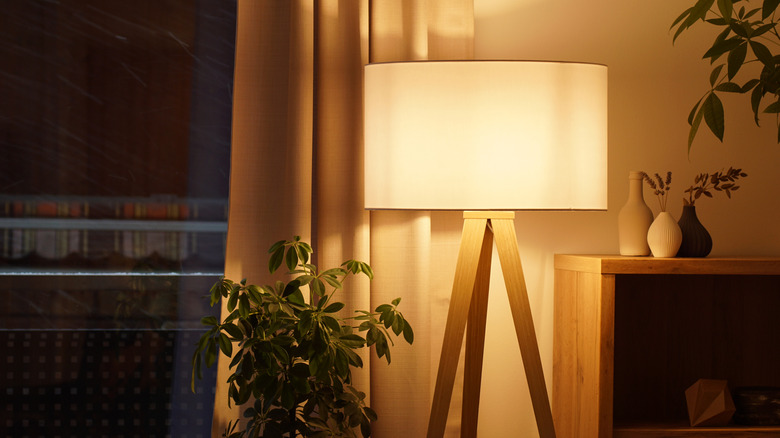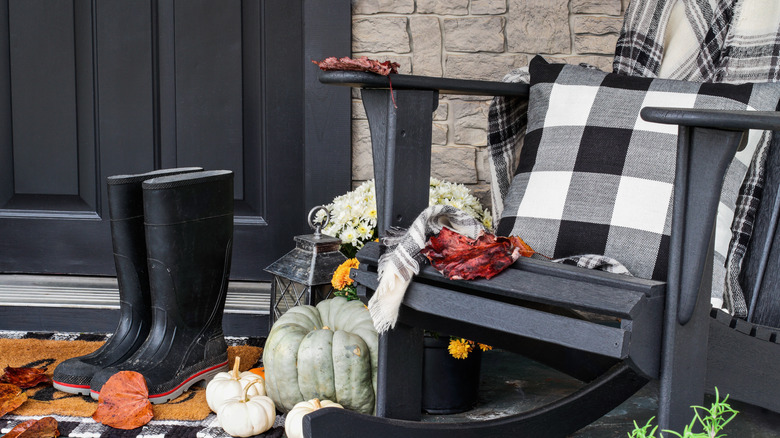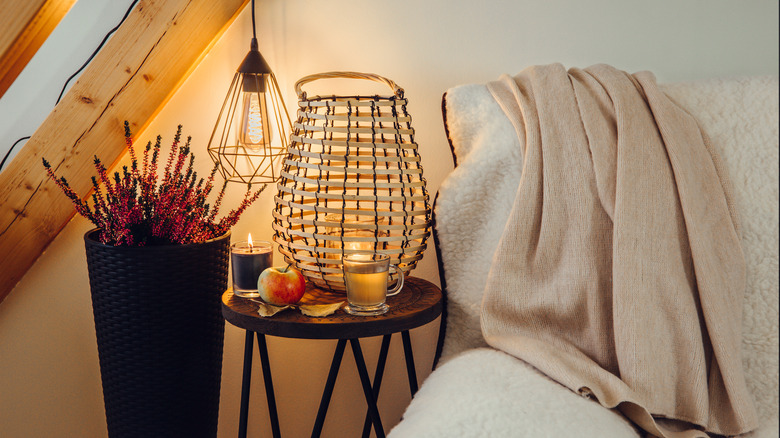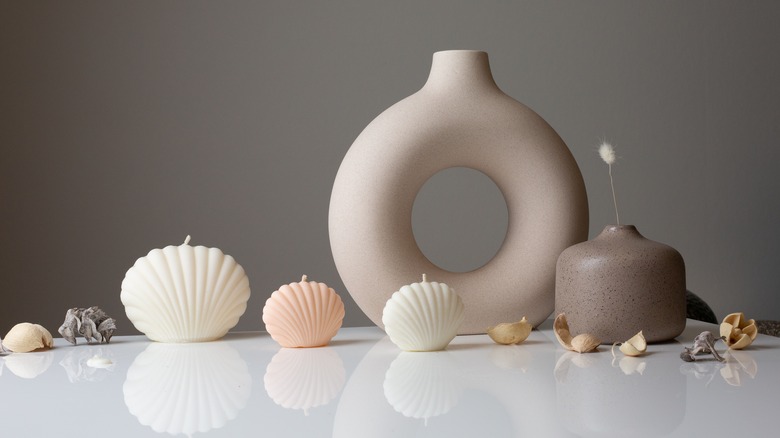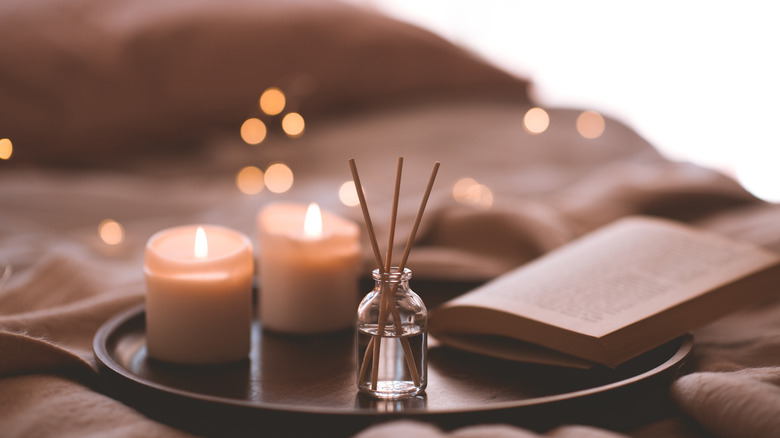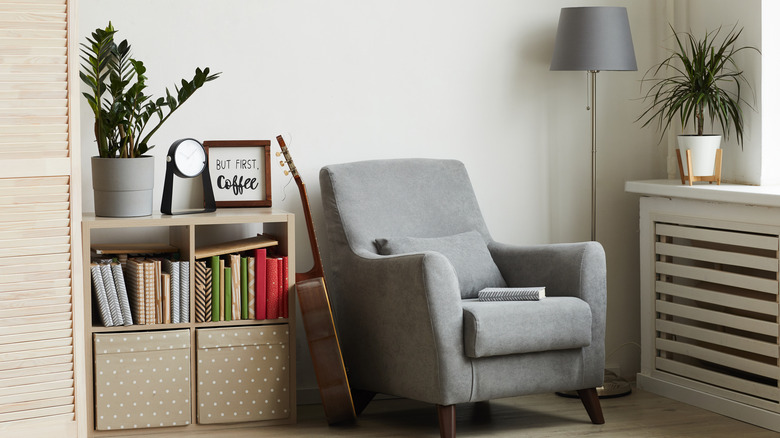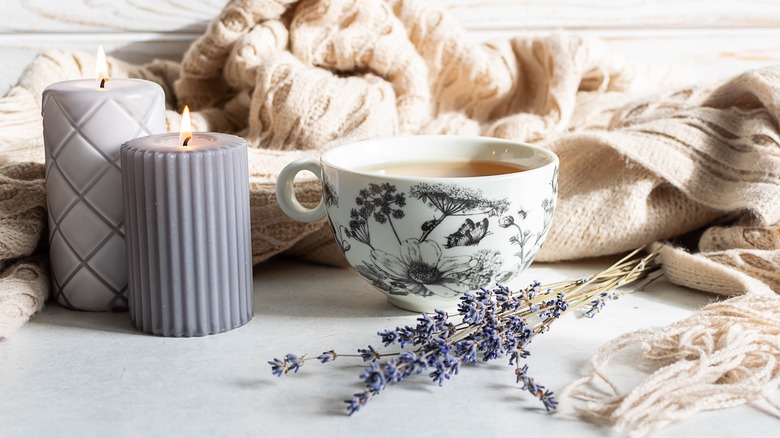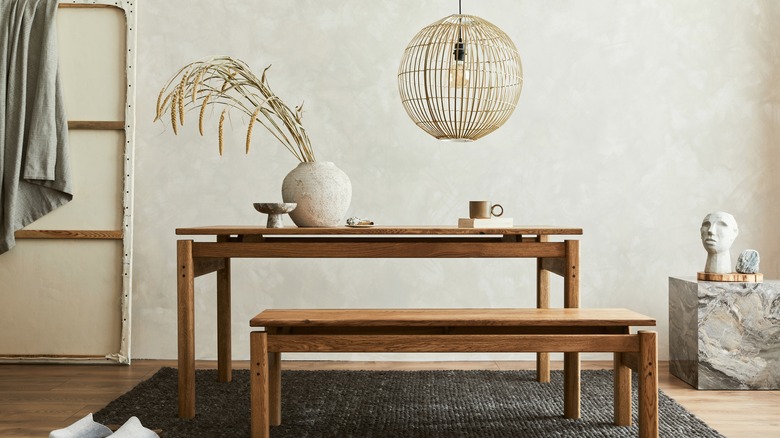The Ultimate Guide To Hygge Decor
We all aspire to have an inviting, cozy, and calming home, a place that welcomes us after a long and hectic day. The hygge design trend has emerged over the past few years, partially because of the best-selling book, "The Little Book of Hygge," which introduces readers to the Danish secret of happy living. According to Country Living, hygge, pronounced "hoo-ga," is a word unable to be translated but encompasses coziness and living in the moment.
Followers of hygge describe it as the feeling of reading by a window while it rains or drinking a warm cup of coffee on a cold day. Hygge is those little moments that encourage us to live a simple life that we enjoy. For this reason alone, many people strive to bring hygge into their homes with design techniques. Scandinavian coziness has found its way into design, food, and lifestyle trends since its boom in 2017 (via The New Yorker). Many followers of hygge swear by its methods to help them deal with seasonal affective disorder and feelings of sadness or mundane blues. Want to inject your home with comfort and coziness? Take a look at this guide to maximize hygge.
Benefits of hygge
Since we're all spending more time at home, there's been a shift to coziness in the interior design industry. In their 2022 prediction report, Woodpecker Flooring claims COVID-19 changed how we interact with our environments, making cozy and sustainable styles, like hygge, Scandinavian, and japandi more popular. Incorporating plants into decor, refurbishing furniture, using glass, muted color palettes, parquet flooring, and lighter colors are becoming trendy again. These design elements encourage the feeling of warmth and coziness. They've been used throughout history, including parquet flooring in the historical regency period and light color palettes displaying versatility and simplicity in Scandinavian-inspired design.
Not only are these design elements beautiful, but they can have benefits for our body and mind. Incorporating hygge into your life decreases adrenal responses and lowers cortisol levels (via Piedmont). Hygge is a practice that helps people become more present and happy in their day-to-day lives.
Adapt color palettes
Design trends come and go, but a few things always remain consistent. For example, neutral color palettes will always convey calmness and warmth. According to Columbia Paint, neutral color palettes are popular because they create a blank canvas that allows you to change your space. They also allow you to play with textures, layering, flooring, and decoration without taking away the story your decor conveys. While hygge tends to follow a color palette based on your space, you may need to alter the palette to bring in a cohesive sense of warmth.
Hygge colors follow Scandinavian trends and incorporate warmer whites and grays (via Benjamin Moore). You can use interior design principles to shift colors and create a warm look in specific rooms. Every single room in your home gets a different degree of natural light. Depending on where the room faces, the light may be cool or warm at certain times of the day (via The Founders Club). To keep a room looking warm and cozy all day, apply specific principles in your rooms. Cool-facing rooms need more warm tones, while south-facing rooms bring out details and brightness. Rooms facing the left benefit from golden hour and sunrise, making them beautiful and cozy in the morning and night.
Layer in textures and different materials
Hygge is known for its beautiful and layered use of texture. According to Foyr, layering is a technique used by interior designers to bring in different elements cohesively, helping the room have depth and more character. When we think of layering from a decor perspective, we usually think of cozy blankets and pillows, but it's more than that. You can incorporate layers of texture with wall coverings or artwork. These are added to a room to bring visual depth and help your eyes engage, creating visual interest. Another great way to incorporate texture is to layer rugs. Layering rugs on a carpet is a renter and move-in-friendly look (via Julie Blanner). Focus on adding rugs with character, like Turkish or teak rugs. Use neutral colors and pay attention to scale to help a room stay cohesive.
To successfully layer in a room, start with a statement piece and work around it, playing on elements you like and downplaying things you want to avoid. For example, if a room is small and you want it to be cozy, play on its size using smaller and less detailed furniture, but use bookshelves to raise the eye. This tip makes the room appear taller and less claustrophobic, creating visual interest.
Get organized and avoid clutter
As a general rule, clutter isn't cozy. While maximalism is trendy in interior design, it does not feature in Scandinavian styles like hygge or japandi. Organized Interiors recommends eliminating items that aren't essential or give us value. Instead of keeping older built-in storage solutions, consider replacing them with a more intuitive organization system. We all function differently, so it makes sense that we decorate and organize differently. Organizing and downsizing will make your life easier.
First, figure out your organizational style (via Sane Spaces). Some people need visual cues, and clear containers stacked in a closet can help prevent over-purchasing and clutter. Other people are naturally inclined to stash items out of the way, so having storage organizers that look beautiful will help avoid clutter. Additionally, if you're someone who saves items for later, putting everything into a designated spot and organizing them in bins makes perfect sense.
Decorate with greenery
Decorating with plants has been an interior design staple for centuries. Humans gravitate toward plants and nature, so it makes sense we'd want to bring them into our homes. While they're beautiful and make great decor, they also have many benefits. According to Martine Claessens, plants help purify the air, create a relaxing atmosphere, and help get rid of unwanted bugs.
People who want to decorate with plants or pick up gardening as a hobby should start simple (via Stauffers of Kissel Hill). Plants need to be taken care of, and some plants require different levels of attention. However, apps like HappySprout help keep your houseplants healthy. In terms of hygge, plants make a space more relaxing because they bring life into a room (via Monrovia). Plants can fill dead space and empty walls, transforming them into something beautiful and layered that helps us feel calm. If you're looking to add plants, play with different sizes and potting arrangements. You can place small plants on walls using specially designed wall pots or hang vines off a high wall where nothing else can be displayed. Having big-leaf houseplants in entryways is a great way to set the theme of your home and welcome guests. Making a home for your plants in corners is good feng shui, and it makes a space feel more relaxed.
Use technology to make your space more cozy
Smart appliances have made changing the atmosphere of our spaces easy and affordable. Rather than knocking down walls or incorporating different lighting, we're now able to add smart light bulbs that can mimic candles and mood lighting or fake fireplaces able to clean the air while looking like the real thing. While hygge has common traits to make a space cozy, you can choose how to apply the philosophy to your home. You should never copy a design aesthetic simply because it's beautiful. Apply it to the way you live and what you like. There are plenty of customizable ways to use technology for your hygge-inspired design.
According to Triangle Gardener, you can install window curtain sensors that open at different times of the day. These curtains help you wake up to sunlight instead of a blaring alarm. You're also able to have speakers that aesthetically match your decor while still being able to play music around your entire home. The best Scandinavian lighting maximizes light without being too harsh (via Scandinavian Standard). Depending on the direction of your room, you can use a smart light bulb to control the light at different times of the day.
Layer your lighting
A top designer decor hack is to layer your lighting. This tip keeps a room's atmosphere controllable and more cohesive with the entire space. In hygge and Scandinavian designs, lighting plays a central role in establishing a mood. According to Lightology, you can achieve this with LED lightbulbs that mimic a warm glow.
Depending on where your room is facing, you may need to incorporate cool light. This part is where layering light comes in. Lighting comes in separate categories. Ambient, which is your overall light that establishes an ambiance in the room, is usually achieved by the primary lighting fixture (via Alden Miller Interiors). For hygge rooms, this will be a warmer tone of light. Accent lighting helps a room look more decorative and put together. In hygge, this can be a sculptural lamp or chandelier with wood or glass or even a Moroccan-inspired lamp that reflects shapes on the wall. Lastly, work in task lighting. Task lighting is for completing a task. These might be LEDs near a sink in the kitchen or a side table lamp for reading in a bedroom. These lamps help prevent eye strain and improve focus. However, they don't need to be cool-toned lighting. You can adapt it to what helps you focus, whether warm tones, daylight bulbs, or LEDs.
Play with pillows and throws
If you have a hygge-inspired room with a neutral color palette, you may find it difficult or scary to add color. Bringing color into a room with textiles is a great way to blend them naturally without overwhelming the space. Thistlewood Farm recommends adding texture to throw blankets by draping them in practical places, like over a couch or armchair. After all, decor should also be functional, and these are places you'll naturally use a throw blanket. Make the throw look cozy by laying it flat over the surface. You can also fold a knitted throw and place it at the end of your bed.
Additionally, if you want to decorate with pillows, focus on symmetry when arranging them (via Ballard Designs). Instead of overlapping surfaces, keep things structured in groups of two or three. This tip prevents a space from looking cluttered and keeps surfaces functional. Another pillow hack is when you're mixing print, focus on one basic print, one busy print, and a solid color that ties them together. You can incorporate this into your home by using a printed ceramic drum as a side table and placing a textured chair next to it with a solid-colored pillow matching the drum.
Decorate with cozy textiles
A simple way to increase the coziness of a space is to use soft and inviting textiles. Cozy fabric can make a home feel warm and welcoming, even in winter. Add small details like velvet trim to a lamp shade or the edge of a chair. Satin pillowcases add contrast to the harshness of wood or grasscloth wallpaper. Additionally, throw blankets made from wool can be draped across chairs or folded in baskets. This textile helps soften whatever surface it's applied to while bringing practically into the space.
Layer textiles and colors by playing with scale, especially by showcasing bold prints or patterns (via Toll Brothers). Instead of picking large decorative pieces, focus on smaller items with pattern designs and tie them in with colors or textures that complement them. For example, you can place a faux fur throw next to a patterned pillow to tone down the harshness of bold color in a neutral room.
Create a spa-like bathroom
A room that's commonly forgotten about is the bathroom. Montana Happy claims a hygge bathroom provides the feeling of warmth and calmness. You can create this vibe through lighting, wellness products, or cozy decor. Adding in a rain head fixture will mimic the feeling of summer rain (via Carosella Design Build). Other people choose to install a steam shower to disperse essential oils throughout the room. If you cannot afford a steam shower, you can achieve this using a cordless diffuser and placing it on the countertop outside of your shower or bathtub.
Luxury linens create a spa-like atmosphere and will make your bathroom feel like a wellness retreat (via Lindye Galloway). You can include different textures in your bathroom, like a brass sconce instead of overhead lighting or a teak-inspired bath mat. Additionally, having more ambient light instead of bright daylight will create a calming atmosphere. To achieve this, get blinds if you have a window in your bathroom and use LED candles or warm-toned lighting to invoke a sense of calm.
Get creative with candles
Candles are a must-have for hygge decor because they're so calming. According to Fraendi, Denmark, the country hygge originated in, doesn't receive much natural light during winter. Therefore, lighting plays a significant role in hygge design. By keeping your candles burning, you can make an atmosphere more intimate and inviting, instead of industrial and cold. In Denmark, candles are "instant hygge."
Match your candles to the room's color scheme or bring in textures and rustic elements, depending on the container (via Lakeside). Additionally, you can place candles in lanterns or decorative holders that interact with light, bouncing shapes off the walls or nearby surfaces. Candles can also be mixed in size and layered on a surface to create visual interest, especially when topped on a tray or in a wooden bowl. If you cannot decorate with real candles, use LED versions. Many are app-controlled, and you can purchase them at any home improvement or decor store. Bring a realistic touch to fake candles by melting candle wax on the edges (via YouTube).
Create welcoming corners
You can't always apply hygge to every room in your home. Instead of incorporating the principles everywhere, focus on a small corner or unused closet to create a cozy corner or nook. Life With Dee suggests choosing a small spot away from the rest of the home and placing a chair in it. Next, grab a side table with a warm lit lamp and layer in cozy items like blankets, candles, or fairy lights strung against a wall. Focus on what makes you feel comfortable and apply it to the space.
Additionally, you can build a little reading nook that functions as a cozy corner (via Iekel Road Home). Remove a door from an unused linen closet. To do this, take off the door and remove any molding. By removing the molding and door frame, you're making the space look built-in rather than just used for something other than its purpose. Next, you can build a simple bench or add a small chair and end table. Lastly, decorate with your favorite things, like rugs, weighted blankets, colorful lights, and books.
Fill your home with what makes you feel cozy
Cozy is subjective. While interior designers have guidelines for trends, it doesn't mean you have to follow those things to make your space comfortable. According to Star Furniture, you can use rugs to make a room feel cozier. A room without one can appear empty and unfinished. Additionally, you can opt for an ottoman instead of a traditional table. This tip can also provide additional storage to keep your space clean and clutter-free.
Add personal touches with DIY projects to create a cozy room (via Havenly). You can create a headboard using plywood and paint or paint a mural on a bedroom wall instead of a headboard. Additionally, instead of painting a space white, you can choose to follow the moody Scandinavian trend of painting a wall black. To decorate a space with black walls, use neutral colors as accents, and keep in mind black will soften almost any texture. It makes knitted material appear even cozier and softer by contrast.
Embrace wabi sabi
Wabi-sabi is a popular Japanese philosophy applied to interior design trends in recent years. According to Japanology, wabi-sabi is the concept of finding beauty and serenity in objects and designs because they're simple, imperfect, and impermanent. This idea appears in interior design by showcasing the imperfections of natural materials (via MyMove). Instead of fixing rough edges on a scuffed table, wabi-sabi would embrace the imperfection. For example, you can mend a broken bowl and use it as a catch tray for display.
A great way to incorporate wabi-sabi into your space is to include personal touches or focus on natural elements, like wood and clay (via Foyr). Like many Scandinavian interior trends, you can also make your bed in whatever way you think looks right. Instead of following a specific ritual or using decorative pillows and top sheets, drape duvets and throws in a way that's beautiful to you.
